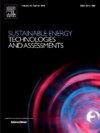Field-to-wire: the environmental sustainability of bioenergy generation from the biomass of agricultural residues
IF 7.1
2区 工程技术
Q1 ENERGY & FUELS
Sustainable Energy Technologies and Assessments
Pub Date : 2025-07-01
DOI:10.1016/j.seta.2025.104433
引用次数: 0
Abstract
Agricultural residues offer a promising alternative for renewable energy production. This study explored the energy potential and environmental impacts of using residual biomass from wheat, barley, oats, olive trees, grapevines, and artichokes to generate bioenergy. A comprehensive “field-to-wire” approach was adopted utilizing Life Cycle Assessment (LCA) to evaluate the entire supply chain from the field-level collection of agricultural residues to energy generation and grid integration.
Agricultural residues present a significant bioenergy potential of 3,900 terajoules (TJ) in the investigated area. Despite the sustainability benefits of bioenergy, this study underscores that field operations represent significant environmental burdens and contribute up to 50 % of the total energy demand and emissions. In areas where transportation distances are high, such as for grapevines, the logistics of biomass delivery can represent 40 % of the total impact of the supply chain. This study also assesses key sustainability metrics and reports an Energy Payback Time of 2.7 years, a Carbon Payback Time of 6.38 years, and an EROI of 7.40, which are all well above the sustainability threshold. These findings highlight the important role that agricultural residues can play in advancing renewable energy goals, reducing greenhouse gas emissions, and contributing to rural revitalization. However, optimizing field operations, transportation logistics, and residue collection methods is essential for maximizing the efficiency and sustainability of bioenergy systems.

从农田到电线:从农业残留物的生物质中产生生物能源的环境可持续性
农业残留物为可再生能源生产提供了一个很有前途的替代品。本研究探讨了利用小麦、大麦、燕麦、橄榄树、葡萄藤和洋蓟等剩余生物质生产生物能源的能源潜力和环境影响。利用生命周期评估(LCA),采用了一种综合的“从田间到电网”的方法来评估从田间农业残留物收集到能源生产和电网整合的整个供应链。在调查地区,农业残留物具有3,900兆焦耳(TJ)的显著生物能源潜力。尽管生物能源具有可持续性优势,但该研究强调,现场作业带来了巨大的环境负担,占能源需求和排放总量的50%。在运输距离较远的地区,如葡萄藤,生物质运输的物流可占供应链总影响的40%。本研究还评估了关键的可持续性指标,并报告了2.7年的能源回收期,6.38年的碳回收期和7.40的EROI,这些都远远高于可持续性阈值。这些发现强调了农业残留物在推进可再生能源目标、减少温室气体排放和促进乡村振兴方面的重要作用。然而,优化现场操作、运输物流和残留物收集方法对于最大限度地提高生物能源系统的效率和可持续性至关重要。
本文章由计算机程序翻译,如有差异,请以英文原文为准。
求助全文
约1分钟内获得全文
求助全文
来源期刊

Sustainable Energy Technologies and Assessments
Energy-Renewable Energy, Sustainability and the Environment
CiteScore
12.70
自引率
12.50%
发文量
1091
期刊介绍:
Encouraging a transition to a sustainable energy future is imperative for our world. Technologies that enable this shift in various sectors like transportation, heating, and power systems are of utmost importance. Sustainable Energy Technologies and Assessments welcomes papers focusing on a range of aspects and levels of technological advancements in energy generation and utilization. The aim is to reduce the negative environmental impact associated with energy production and consumption, spanning from laboratory experiments to real-world applications in the commercial sector.
 求助内容:
求助内容: 应助结果提醒方式:
应助结果提醒方式:


